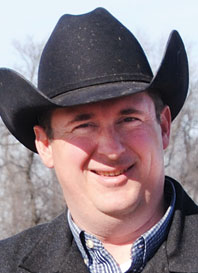
Long before the temperature mellows, the grass greens and buds begin, Brad Ketterhagen has been preparing for spring’s arrival.
In some ways, Brad is always thinking about spring, the principal season for calving on his Barry County farm near Crane, Mo., where he keeps a herd of about 40 commercial Red Angus-cross, as well as a growing herd of registered Red Angus.
Brad’s choice of Red Angus as a base for his commercial herd stems from his years of growing up on a Wisconsin farm, where his dad raised registered Black Angus, and later experience as manager of the 600-acre Hidden Creek Farm in his home state, where the primary focus is on Red Angus.
“I was exposed to the breed growing up, so I knew a little about the type and kind of cattle they are,” Brad said. “I like the business end of things on both black and red because there is a large registered market and a lot of genetic selection. But, I prefer the reds because there are a no-frills, real world breed.”
Brad says that Red Angus are perfect as a crossbreed, especially in the commercial sector. Among the breed’s traits that Brad values are good maternal instincts, good milk production for calves, calving ease, adaptability to various environments (“They thrive in all parts of the U.S.,” Brad noted.), along with good general health, weight gain and disposition.
In addition, carcass qualities are high, with desirable marbling and ribeye. “They improve the meat when crossed with other breeds,” Brad said.
All animals, even his commercial cows, are ear tagged and tattooed for easy identification, and Brad records every birth weight, weaning weight, yearling weight and any other tidbits he feels are pertinent. As soon as possible, he transfers the information from his pocket notepad to a computer.
“Anything I can… I put in the computer program – how much mineral I feed, how much hay I put out, how much feed I buy for the young stock,” he said.
While keeping records that extensive may not be for everyone, there are three things any producer can do to get a better picture of his operation, Brad said: insert ear tags, record birth weights and weigh calves when weaned or sold. “And you can do that on a piece of paper,” he said.
Keeping even minimal records can help a producer see which cows are producing calves every 12 to18 months and which didn’t have calves last year.
“You’re able to get a good picture of your herd – when they calve, when they’re bred, breeding dates and records,” Brad said. “You’re able to quickly see which cows are earning their keep and which are not.”
“If you want to be around in 10 years, you have to know what your costs are, not just how much you get for your calves,” he added. “You have to know how much it costs to make those calves.”
Those records also will give a good picture of how the quality of a herd — and each calf crop — is improving over time. And will help ensure that every spring is a good one.







